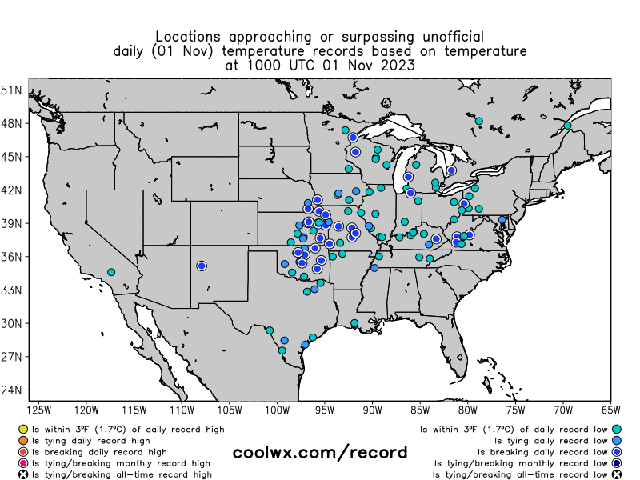LOW TEMPERATURE RECORDS CONTINUE TO FALL, AS DOES THE SNOW
The past 24-hours have delivered additional headaches to the jittery, coffee-spitting “look, the weather is killing us!” climate brigade, as the United States felled hundreds-more low temperature records.

From California to Pennsylvania, daily records have fallen (between 10:00 Nov 1 – 09:00 Nov 2 UTC):
Michigan, for example, posted a myriad of new snowfall records this week, such as in Muskegon, which saw 8.8″ (some reports say 10″); in Flint, which registered 1.1″; in Saginaw with its 0.5″; and also Detroit with 0.2″ — all new records.
In fact, that Muskegon record was a biggie, and led to two additional records falling, and all.
The 8.8 (or 10) inches smashed the old record of just a trace that has occurred on 10 separate Halloweens since 1917. Furthermore, October 31, 2023 is now the snowiest October day ever recorded in Muskegon. And October 2023 is now the city’s snowiest month of October, breaking a record set well-over a century ago in 1910.
Likewise in Wisconsin, Eau Claire had its Streets and Fleets division plowing the roads to clear record-breaking Halloween snow.
“Ever since the point of record, which goes back to the late-1800s, we’ve only had measurable snow three times prior to today,” said local meteorologist Mike Dandrea. “Our previous record was two inches. That was set back in 1932 and today, so far, we’ve gotten 2.1 inches of snow.”
Similar stories are being told up and down and across the country — but you get the picture.
Prior to these Halloween-week falls, snow and record-cold temps had already put harvest on hold across the northern Plains. As much as 2 feet of snow hit parts of the Midwest last week, such as North Dakota and northwest Minnesota.
18 inches clipped the North Dakota town of Lankin. Other double digit totals were noted in Washburn and Harvey (14 inches) as well as Minot and Williston (11 inches). Further east, Leeds reported 8 inches and Larimore and Grafton saw 8.5 inches.
Record low temperatures then swept the snow-covered areas, holding daily highs below freezing for days.
Some sunflowers, corn and soybeans fields were all unharvested when the first snow fell, said Randy Mehlhoff, North Dakota State University Langdon Research Extension director.
The sunflower harvest in ND was less than half completed when the storm barreled in.
As of the week ending Oct 29, 38% of the state’s sunflowers were harvested, according to the USDA’s National Agricultural Statistics Service. On average, 47% of sunflowers were harvested by this time, the agency said.
It’s not unusual to harvest sunflowers after a snowfall, but because the snow was wet it stuck to the heads and will have to melt before the crop can be combined, said John Sandbakken, National Sunflower Association executive director.
“It’s going to slow down things this week, for sure,” said Sandbakken on Oct 31. “It’s still early and hopefully we don’t get more snow.”
GFS Total Snowfall (inches) Nov 3 – Nov 10 [tropicaltidbits.com].
A late season polar blast has gripped Southern Africa of late, where temperatures in some areas plunged 20C in 24 hours.
The mountains of Lesotho are freezing and rare snow is falling. Likewise, parts of the Eastern Cape, Free State and KwaZulu-Natal awoke to breathtaking scenes as their gardens matched the snow-tipped peaks of distant mountains.
Barkley East, Elliot, and parts of Matatiele, south of the Drakensberg, have been turned into a winter wonderland, reports news24.com. Snow has capped the Sneeuberg, Winterberg and the Drakensberg mountains, and all.
The SA Weather Service said other parts of the country that experienced snowfalls were the eastern parts of the Free State and mountainous parts of KwaZulu-Natal.
Both the public and experts have been left baffled by the unexpected snowfall, continues news24.com.
“It is strange, it is just that it is really not frequent during this time of the year due to the dynamics that usually dominate the weather,” said local meteorologist Lelo Kleinbooi. “It’s spring/summer now.”

SOLAR FILAMENT INBOUND
A solar magnetic filament erupted on Halloween night, carving a “canyon of fire” in the sun’s southern hemisphere.
Recommend this post and follow
The Life of Earth






No comments:
Post a Comment
Stick to the subject, NO religion, or Party politics